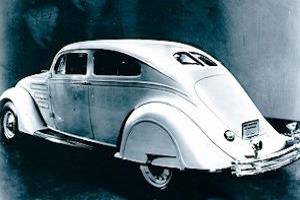The Airflow today resembles a seminal example of motorized Art Deco. It was an extremely adventurous car for Chrysler but, sadly, a disaster in sales terms. Company founder Walter Chrysler had great faith in a team of consultant engineers nicknamed the “Three Musketeers” Carl Breer, Fred Zeder, and Owen Skelton. It was Breer’s fascination with aerodynamics that led the trio to map out America’s first mainstream car with this science as its guiding principle.

Chrysler Airflow 1934
- YEAR REVEALED 1934
- PLACE OF ORIGIN Detroit, Michigan
- HISTORICAL STATUS production car
- ENGINE eight-cylinder, 298ci (4,883cc) (others up to 385ci/6,306cc)
- MAXIMUM POWER 122bhp
- LAYOUT front-mounted engine driving the rear wheels
- BODYWORK two- or four-door six-seater sedan
- TOP SPEED 88mph (142kph)
- NUMBER BUILT 29,345
By 1930, they had tested over 50 different experimental models in a wind tunnel constructed with input from aviation pioneer Orville Wright. To improve ride and handling of what became the Airflow, they shifted the engine forward over the front wheels and positioned the passenger seats within the wheelbase, for better weight distribution. To cut weight they also devised a one-piece body with a lightweight metal frame (as opposed to the more common heavy, timber framing).
Early Airflows were, apparently, fraught with quality problems because of new welding techniques. But the main problem with sales was public resistance. Buyers preferred their cars to be more traditional-looking than the amorphous visage and faired-in wheels of the Airflow. Ironically, in an attempt to boost sales, the car was actually made less aerodynamic in 1936 when a prominent trunk was added to its tapering tail but, by then, Chrysler’s more traditional cars were outselling it massively. It was axed after 1937.